On the Remembrance Trail in France
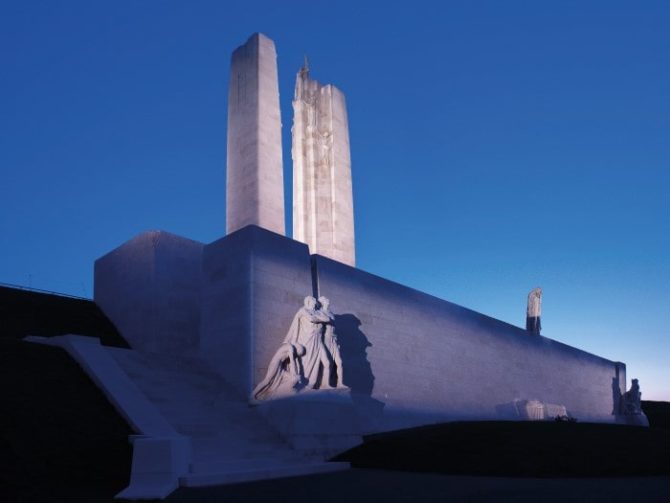
The north of France has seen some of the greatest bloodshed ever known to man, not just on its battlefields but in its towns and villages, too, as two world wars ravaged the land and its people. Justin Postlethwaite explores the sites, monuments and museums dedicated to those who so bravely gave their lives.
All lovers of France have their wish-list of places to visit and experiences to savour, from the cultural to the gastronomic, the architectural to the topographic. However, easily the most vital, meaningful and humbling trip you can ever make is to its battlefields, war museums and remembrance sites. From the World War II D-Day landing beaches in Normandy to the Somme and Verdun’s World War I-scarred landscapes, you will embrace history, honour the human spirit and depart feeling infinitely more respectful of the sacrifice and horror that befell millions in wartime.
In this multi-regional round-up, we explore some of the best places to pay respect to the dead from both wars, and reveal the finest memorials and museums – from the epic to the tiny. As well as the chilling facts of military history, many of these also provide riveting social backgrounds to life before, during and after war came to French towns and villages, leaving even its landscapes as living museums, forever scarred.
Note: Space does not permit us to provide in-depth guides or historical detail for each site, nor is it possible to list every cemetery or museum; rather, we hope that our selection serves as inspiration to plan your own trip soon, perhaps by exploring the many superb websites and social media channels relating to remembrance tourism in France.
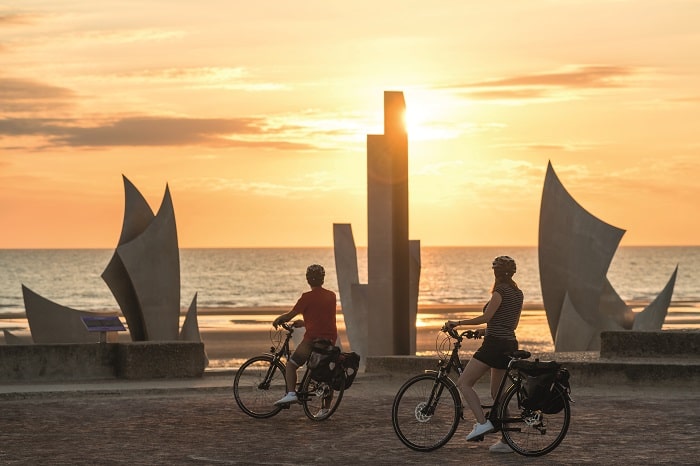
Cycling along Omaha Beach. © Emmanuel Berthier
WORLD WAR II
NORMANDY
D-Day Landings is the term commonly used to refer to the Normandy invasion by some 156,000 Western Allied troops (61,715 British, 73,000 American and 21,400 Canadian) on June 6, 1944. The invasion kicked off the Battle of Normandy, which marked the beginning of the end for Hitler’s German occupation of France, and within a year the war was over.
The Allied forces suffered nearly 10,000 casualties; more than 4,000 were dead (among them 2,499 Americans, as verified in 2016 by the US National D-Day Memorial Foundation).
Normandy today, with its many superb museums, historical sites, cemeteries and cultural and teaching facilities, is like an open-air history book. If you have limited time, pick your destinations carefully – it is impossible to visit everything, even in a week. There are many ways to tour the region and view sites – you may consider a fat-bike ride along Omaha Beach or even kayaking around the Mulberry Harbour at Arromanches. An application for the D-Day Landing beaches to be included on the list of World Heritage sites is still pending a decision by UNESCO. To gain entry to these cultural sites, always check Covid health pass (passe sanitaire) requirements for each one before travelling.
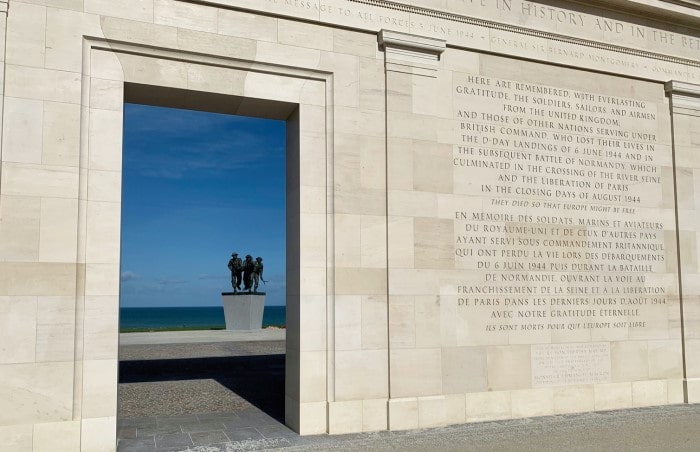
The British Normandy Memorial was unveiled on June 6 last year. © Emmanuel Berthier
MUSEUMS AND MEMORIALS
June 2021 saw the unveiling of the new British Normandy Memorial, designed by British architect Liam O’Connor with a sculpture by David Williams Ellis. Located just outside Ver-sur-Mer overlooking Gold Beach, it was conceived by The Normandy Memorial Trust (created in 2016), and is the only single memorial to the 22,000 British Armed Forces fallen.
All five landing beaches have a museum and there are many others where you can learn about the Battle of Normandy. Omaha Beach Memorial Museum recounts in harrowing detail the day’s events, through dioramas, an extensive collection of uniforms, vehicles and memorabilia.
Utah Beach Museum recounts the story of D-Day in 10 sequences, from the preparation for the landing, to the final outcome and success. Among its rich collection of objects, vehicles, materials and oral histories is an original B26 bomber – one of only six left.
In Courseulles-sur-Mer, the Juno Beach Centre pays homage to the 45,000 Canadians who lost their lives during the war, of whom 5,500 were killed during the Battle of Normandy, and 359 on D-Day. It is manned exclusively by Canadian guides.
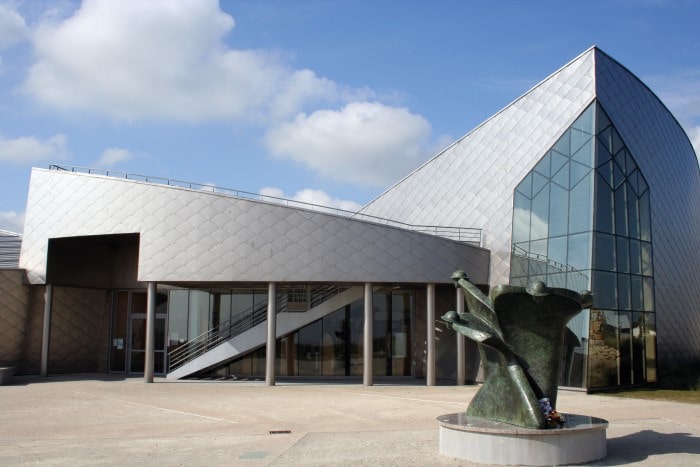
The Juno Beach Centre in Courseulles-sur-Mer. © Loic Durand
Gold Beach Museum explores how British troops advanced on Gold Beach on June 6, 1944, via scale models, slide shows and photographic documents while The America Gold Beach Museum is a short walk from Gold Beach.
Finally, at Sword Beach, the Ouistreham French-British Museum of Commando N°4 is unique in that it recounts the story of Philippe Kieffer’s French contingent of commandos that stormed the shore that day.
Nearby is the Atlantic Wall Museum, housed in a 52-ft restored German bunker. Here, soldiers were holed up for three days after the Sword Beach landing until British troops, literally, blew them out. D-Day Museum (called the Musée du Débarquement d’Arromanches in French), which overlooks the exact landing spot on the beach of Arromanches, was the very first museum dedicated to D-Day back in 1954. It has undergone extensive and expensive upgrades of late.
Elsewhere, the Overlord Museum in Colleville-sur-Mer (opposite the Normandy American Cemetery), offers life-sized reconstructions, plunging visitors into the heart of the action, while Bayeux’s Museum of the Battle of Normandy is a real gem, with dioramas and archive footage.
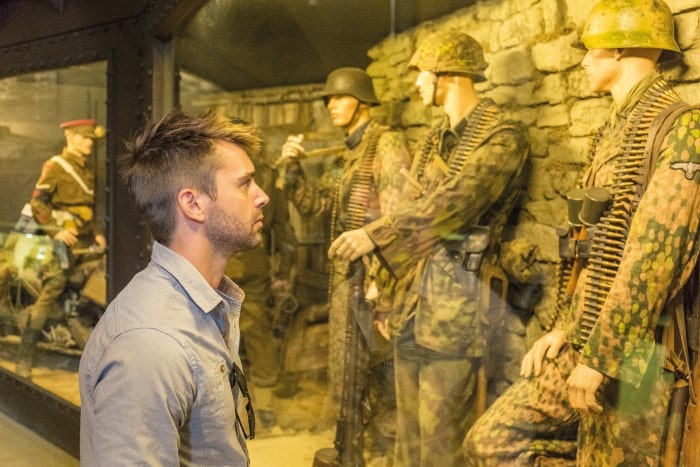
The Overlord Museum in Colleville-sur-Mer offers life-sized reconstructions. © Vincent_Rustuel
The Airborne Museum in Sainte-Mère-Église showcases the parachute drops and brave fighting by US paratroopers of the 82nd and 101st Airborne Divisions.
Also here on the Cotentin Peninsula (in the Manche département) is the Memorial Museum of Bloody Gulch. It saw ferocious fighting between German and 101st Airborne US soldiers and many relics remained buried in the ground or hidden in homes for over 65 years. Now visitors can discover what was left by soldiers and hear the testimony of civilians who survived the battle. Also in Manche, at Saint-Côme-du-Mont, discover both the German and Allied perspectives on D-Day at the D-Day Experience, including multi-award-winning film D-Day Normandy 1944 in the museum’s 3D cinema.
Strategically important, Caen was nearly reduced to rubble by daily raids. In 1988, the Calvados capital sealed its commitment to peace with the launch of the Caen Memorial, a sprawling complex chronicling not only World War II, but also the Cold War. Thirty minutes away, the Falaise Memorial shifts the focus to civilians and their unflagging courage through incessant bombings and the choke-hold of Nazism.
Also in Calvados, the Pegasus Memorial Museum in Bénouville (home to the first liberated bridge in 1944), pays tribute to the British 6th Airborne Division, which not only captured the bridge (renamed Pegasus after the war) thanks to daring glider landings, but also held the eastern flank of the landing beaches for 80 days despite heavy losses.
As for aircraft, a brand new museum dedicated to the role of flying machines opened in June 2021. Discover the D-Day planes, the missions and the airmen who contributed to this mastery of the skies in June 1944 at D-Day Wings Museum Caen-Carpiquet in Bretteville-sur-Odon.
Pointe du Hoc Ranger Monument, located atop a bunker on a cliff eight miles west of Omaha Beach, is where US Army Rangers scaled the 100ft cliffs and held off counter-attacks. For a fully immersive visual experience, see the new film 100 Days of the Battle of Normandy, projected on to nine screens at ‘circular cinema’ Arromanches 360.
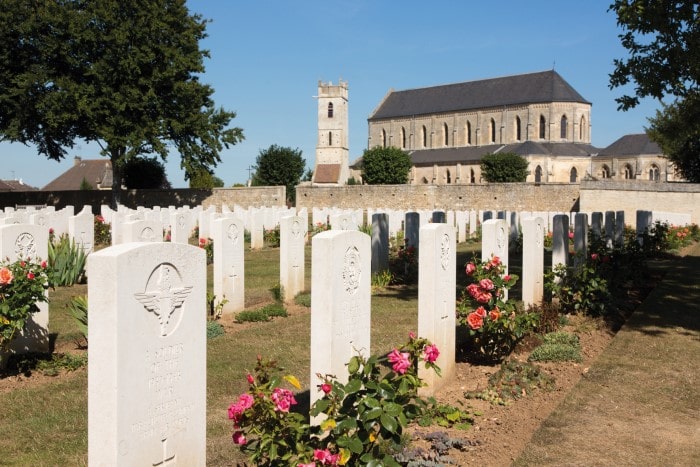
The war cemetery at Ranville, which was the first French village liberated on D-Day. © Arnaud Guerin
CEMETERIES
Whatever your nationality, there are many places to reflect upon the sacrifices made by your brave countrymen in Normandy.
The Ranville War Cemetery for Commonwealth soldiers lies 10km northeast of Caen. The village was the first to be liberated following the capture of Pegasus Bridge. Here lie 2,411 identified casualties, mostly British. Meanwhile, Bayeux War Cemetery is the biggest cemetery of Commonwealth WWII casualties in France with 4,144 graves. On a bluff overlooking Omaha Beach stands the 70-hectare Normandy American Cemetery, lined with the graves of 9,380 fallen soldiers. The memorial consists of a semi-circular colonnade with a loggia at each end containing large maps and narratives of the military operations; at the centre is the bronze statue entitled ‘Spirit of American Youth Rising from the Waves’.
The Brittany American Cemetery and Memorial covers 28 acres of countryside in the Manche and contains the remains of 4,410 American war dead. Along the retaining wall of the memorial terrace are inscribed the names of 498 of the missing, while the granite memorial contains a chapel and two large operations maps with military flags overlooking the burial area. The Canadian Military Cemetery near Bretteville-sur-Laize is where 2,782 Canadian soldiers are buried, 87 of whom remain unidentified. Other Canadians killed in the Battle of Normandy are buried near Juno Beach in the Bény-sur-Mer Canadian War Cemetery.
NORD AND PAS-DE-CALAIS
There is a good choice of museums in the northernmost tip of the Atlantic Wall and thus closest to the UK. In May and June 1940, Operation Dynamo succeeded in evacuating more than 338,000 soldiers to England from Dunkirk in just nine days. The Dunkirk War Museum houses a rich collection of weapons, uniforms, models, photos and maps of military operations.
In Calais, the Musée Mémoire 39-45, located in a bunker that was used by the German army for telecommunications, is an old-style museum with collections of newspapers, propaganda posters, real weapons and uniforms.
OTHER PLACES TO VISIT
Two key sites of Nazi massacres visited upon French citizens are Marsoulas in Haute-Garonne – where 27 people were murdered on June 10, 1944 – and Oradour-sur-Glane in Haute-Vienne, Limousin, where, on the same day, 643 people were killed and the village razed. Eerie and intensely moving, it remains a permanent memorial and museum and is a must-visit.
GETTING THERE
FROM THE UK BY FERRY
Brittany Ferries: Portsmouth to Saint-Malo, Caen and Cherbourg; Poole to Cherbourg; and Plymouth to Roscoff and Saint-Malo.
www.brittany-ferries.co.uk
DFDS Seaways from Dover to Calais and Dover to Dunkirk.
www.dfds.com
BY AIR
Sadly there are no longer direct flights from the UK to Caen-Carpiquet. But many UK and worldwide airlines serve Paris CDG and Paris Orly airports. Car journeys from Paris CDG to Caen take almost three hours, and train journeys from Gare Saint-Lazare about two.
TOURISM CONTACTS
NORMANDY
www.normandie-tourisme.fr
A great, searchable resource within this can be found here.
Plus you can find out which sites welcome dogs and details of a network of qualified English-speaking guides.
CALVADOS
www.calvados-tourisme.co.uk
MANCHE
www.manche-tourism.com
BAIE DE COTENTIN
www.ot-baieducotentin.fr
DUNKIRK
www.dunkirk-tourism.com
WORLD WAR I
Départements to focus on when planning a remembrance trip to the Western Front’s theatres of war from 1914-1918 include Pas-de-Calais, Somme, Meuse, Aisne, Ardennes, Marne and Seine-et-Marne. Verdun (in Meuse) and Somme are household names for visitors because of the bloodiest battles that took place there, but there is so much more to explore – each department offers definitive, humbling glimpses into the endurance of the human spirit in the face of atrocity and destruction, via museums, memorials and even phantom-like ‘destroyed villages’ such as those in the ‘Red Zone’ in Meuse.
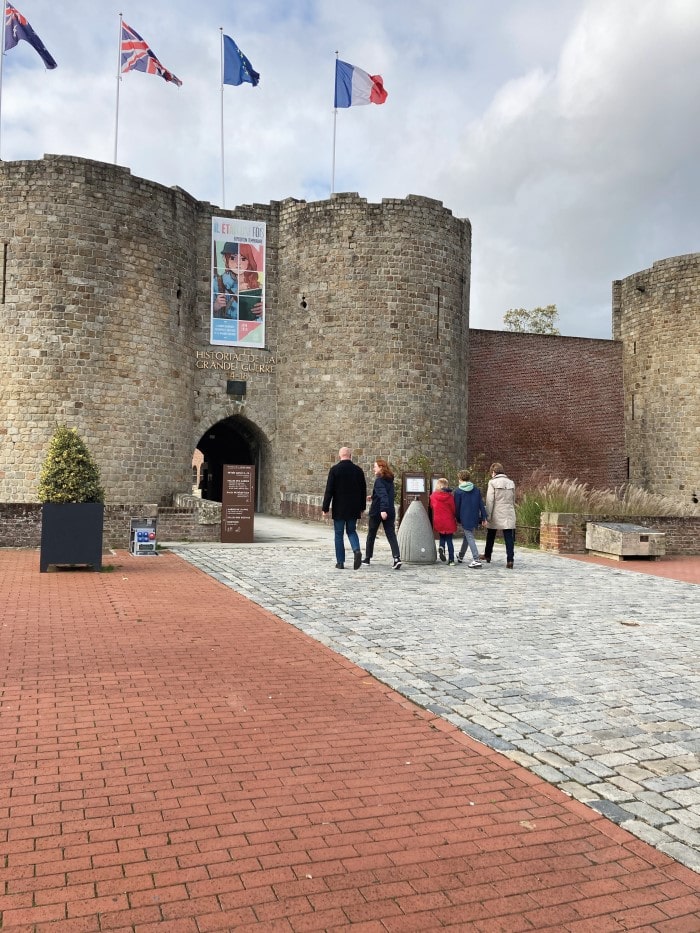
The Historial de la Grande Guerre at Péronne is a great place to find out about the political, military and social background to the Great War. © Somme Tourisme
MUSEUMS AND MEMORIALS
Located in Meaux, Seine-et-Marne, the Musée de la Grande Guerre offers one of the most comprehensive overviews of the Great War through a combination of reconstructed trenches, film clips and audio guides.
Equally epic is Historial de La Grande Guerre in Péronne, Somme. Set in the old castle, it is a great place to find out about the political, military and social background to the Great War. Its sister museum at Thiepval, near the monument was inaugurated in 2016. Exhibition highlights include The Battle of the Somme: The Offensive of Summer 1916 and Aces of Aviation.
In the village of Vignacourt (Somme), keen photographers Louis and Antoinette Thuillier immortalised their meetings with soldiers from all over the world on their farm. They took more than 4,000 glass plate photographs between 1916 and 1918, which were stored in the farm attic and forgotten about – until now. At Musée Vignacourt 14-18, you can discover the poignant stories behind the individual portraits in this very human First World War story.
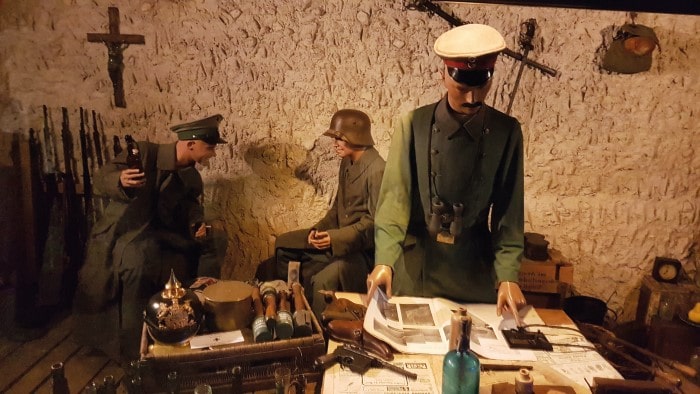
Musee Somme 1916 at Albert explores life in the trenches. © Somme Tourisme
Constructed in the wake of the Franco-Prussian War, Musée du Fort de la Pompelle in Puisieulx (Marne) became of vital importance to the defence of Reims in the Great War, and came under heavy bombardment from the German offensive of 1914. In the 1950s, it was converted into a museum. Displaying artillery equipment and preserved troops’ living quarters, the museum’s chief attraction is its collection of 560 helmets and caps worn by the various regiments of the German Imperial Army. In 2018, the museum was updated and expanded.
Located on the Verdun battlefield, Mémorial de Verdun is a memorial site and superb military museum. Displaying weaponry, medical equipment, photographs and recreated trenches, the museum provides multimedia tours. An important addition for Verdun (the town) in 2021 was the immersive new experience in the underground galleries of the Citadel – a unique, 35-minute scenographic tour in a wire-guided gondola with augmented reality glasses.
In Albert (Somme), the small but passionately curated Somme 1916 Museum is excellent. Here, you will be led along a 250m tunnel that depicts life in the trenches, with a collection of items and knowledgeable guides to rival any on the Western Front.
The Musée du Chemin des Dames in Oulches-la-Vallée-Foulon is the most-visited museum in Aisne. A former limestone quarry 15m below ground, the Caverne du Dragon became a tactical stronghold where underground battles were fought. From here you can follow the Chemin des Dames Memorial Trail to visit other memorial sites of interest in the area.
Musée de l’Armistice in the Compiègne Forest in Oise is built on the site where the Germans signed the Armistice which came into effect at 11am on November 11, 1918. In Arras (Pas-de-Calais), head to the remarkable Wellington Quarry, a museum that also serves as a memorial to those who died in 1917’s Battle of Arras. Visitors don hard hats and descend in a lift for a tour of the quarry, named Wellington by the New Zealand sappers who dug it.
Finally, in Ardennes the Musée Guerre et Paix en Ardennes (Museum of War and Peace in Ardennes) in Novion-Porcien is unique in that it encompasses torrid times over three wars: 1870 (between the Second French Empire – later the Third French Republic – and the North German Confederation led by the Kingdom of Prussia); 1914-1918; and 1939-1945.
MEMORIALS AND CEMETERIES
One of the most iconic Remembrance monuments on the Western Front is at Vimy Ridge, overlooking the Douai plain near Lens (Pas-de-Calais). Set in sprawling parkland, it pays tribute to 11,285 Canadian Expeditionary Force soldiers.
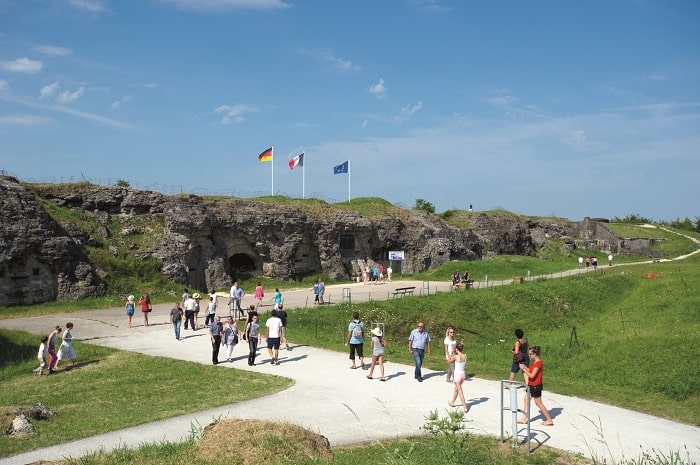
Visit Douaumont Fort in Meuse to witness how soldiers lived and fought. © Guillaume Ramon
Douaumont Fort is the tallest of the 19 forts built in the 1890s following the Franco-Prussian War to protect Verdun from attacks. With accompanying barracks – including dormitories to accommodate 635 soldiers, an on-site bakery and water tank – the building was constantly modernised and fortified in the years leading up to the outbreak of World War II in 1914. Plaques commemorate those who lost their lives here and tell the story of the fort’s capture, as well as its later recapture by French troops in 1916.
Located beside the largest military cemetery in the region dedicated solely to the French, with 16,142 graves, Douaumont Ossuary is a stone monument containing the unidentified bones of at least 130,000 French and German soldiers killed during the Battle of Verdun.
Meanwhile, at the highest point overlooking the Somme battlefields is the world-famous Thiepval Memorial, a colossal arc de triomphe honouring the 72,194 British and South African soldiers who lost their lives here.
Notre-Dame-de-Lorette Memorial is the largest French military cemetery in the world, containing the remains of more than 40,000 French soldiers, with a beautiful basilica and memorial buildings. This is also the location of the Ring of Remembrance, a modern-day sculptural memorial engraved with the names of nearly 600,000 soldiers who died.
Standing on the top of a hill in the grounds of Château de Dormans, Mémorial des Batailles de la Marne is the principal monument to the soldiers who were killed in the two Battles of the Marne. Erected in 1919, with a 52m steeple and a long staircase leading to its entrance, the chapel has unrivalled views over the Marne valley.
In Aisne, to appreciate the courage and sacrifice of American fighters when they entered the war, head to Aisne-Marne US Cemetery next to Belleau Wood, site of heavy US losses in June 1918 (there are 2,289 graves here, though many more died). Again, to fully appreciate the individual US marines’ astonishing tales of bravery, a guided tour is recommended.
GETTING THERE
FROM THE UK BY FERRY
The easiest way to explore northeast France’s World War I sites is by car (or organised tours). From the UK, take the ferry (DFDS Seaways from Dover to Calais and Dover to Dunkirk) or Eurotunnel to Calais.
TOURISM CONTACTS
MEUSE
www.lameuse.fr
PAS-DE-CALAIS
www.visit-pas-de-calais.com
AISNE
www.jaimelaisne.com
SOMME
www.visit-somme.com
MARNE
www.tourisme-en-champagne.co.uk
ARDENNES
http://gb.ardennes.com
HAUTS DE FRANCE
www.french-weekendbreaks.co.uk
From France Today Magazine
Share to: Facebook Twitter LinkedIn Email
More in France history, history, memorials, WWII
Leave a reply
Your email address will not be published. Required fields are marked *




REPLY